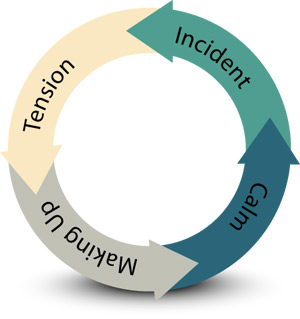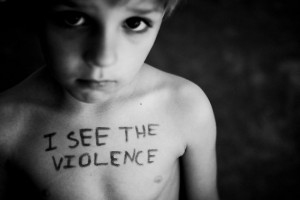Q: What are Family Violence and Domestic Violence? Are they the same?
Often the terms are used interchangeably . Domestic and Family Violence is when someone intentionally uses violence, threats, coercion, force or intimidation to control, manipulate a family member, partner or former partner. Any behaviour that in any way causes a family member to fear for their own, or other family member’s safety or wellbeing is Domestic/Family Violence.
Forms of violence include
- Emotional / Psychological:
Verbal put downs, humiliation, degradation, insults, the undermining of confidence, threats of violence, punishment and manipulation to the victim and experienced/witnessed by children in the family . - Physical
Slapping, hitting, choking, shaking, stabbing, punching, kicking. - Sexual
Rape, sexual assault, sexual abuse, sexual harassment - Social
Isolation and control, denial of contact with family/friends, abuse in public - Economic
Denying of money, controlling finances - Spiritual
Erosion of a woman’s/man’s culture or religious beliefs - Kidnapping
Loss of liberty, being held against one’s will - Cruelty to Pets / Animals
Causing injury or death to an animal irrespective of whether the victim owns the animal - Damage to Property
Destruction of fixtures, fittings, grounds, fences, whether the victims owns the property or not. Damage to vehicles or personal possessions - Stalking
Watching, following or loitering near the victim, persistent unwanted contact via phone, email, postal mail, unwanted cards and gifts.
Domestic and Family Violence:
- Is not the fault of the victim/survivor
- Is a crime and unacceptable in any community
- Has no age/social/gender boundaries
- Occurs in all socio-economic groups and cultures
- Is a violation of a person’s human rights
- Is a criminal offence involving criminal behaviour
Domestic abuse also called partner violence, is the systematic suffocation of another person’s spirit.
The Women’s Council for Domestic & Family Violence Services (WA) 2001 in their literature address the myths and misunderstandings associated with Domestic and Family Violence:
The facts are:
- Domestic and family violence are often hidden as many women and children are too scared to speak out because of the perpetrator’s manipulation of their behaviour in front of other people. Perpetrators often come across as charming and friendly.
- Drug and alcohol use does not cause domestic and family violence. The use of substances can lower inhibitions which lead to an escalation of the frequency and severity of assault. In most cases men who use violence while under the influence are also violent when not affected by drugs and/or alcohol.
- Domestic and family violence is experienced predominantly by women from all social, economic, religious and cultural backgrounds around the world.
- Children and young people who live with violence witness it, hear it and know about it. Being around violence can be just as damaging for children and young people as is experiencing it. The consequences include increased likelihood of physical abuse, depression, anxiety, developmental regression, trust issues and an increased likelihood of becoming involved in a violent relationship as an adult.
- Many women who experience domestic and family violence are in fear for their lives and the lives of their children. This fear is the biggest barrier to women exiting violent relationships. Other barriers include powerlessness and helplessness, being financially dependent upon the partner, lack of support and limited crisis services for women and children to escape to.
- Violent and abusive behaviour is always done deliberately, it is never a loss of control or someone not being able to ‘manage their anger.’ Perpetrators of violence make decisions about how and when they will be abusive and they make plans as to how they will stop the victim from resisting.
In addition to the facts stated above:
- Male victims may also experience multiple forms of abuse including legal and administrative abuse – the use of institutions to inflict further abuse on a victim, for example, taking out false restraining orders or not allowing the victim to access his children.
Impact of domestic and family violence on victims/survivors include:
- Anxiety
- Flashbacks
- Feelings of guilt/shame
- Loss of trust
- Loneliness and isolation
- Unresolved anger
- Physical injuries
- Loss of home/homelessness
- Physical illness
- Mental health issues
- Post Traumatic Stress Disorder
- Fear and loss of feelings of safety
- Depression
- Loss of work
- Financial deprivation
- Suicidal ideation
- Self harm
- Sexual dysfunction
Never let someone who contributes so little to a relationship control so much of it.
Cycle of Violence:

Incident
- Any type of abuse (physical, sexual, emotional)
Tension Building
- Abuser starts to get angry
- Abuse may begin
- There is a breakdown in communication
- Victims feels the need to keep the abuser calm
- Tension becomes too much
- Victims feel like they are ‘walking on egg shells’
Making Up
- Abusers may apologize for abuse
- Abusers may promise it will never happen again
- Abusers may blame the victim for causing the abuse
- Abusers may deny abuse took place or say it was not that bad
Calm
- Abuser acts like the abuse never happened
- Physical abuse may not be taking place
- Promises made during ‘making up’ may be met
- Victim may hope that the abuse is over
- Abuser may give gifts to the victim
“Whoever is dissatisfied with himself is continually ready for revenge”
– Friedrich Nietzsche
Red flags include and are not limited to the following:
(Ref: 1800 RESPECT, in collaboration with inTouch Multicultural Centre Against Family Violence, Elizabeth Hoffman House).
- Previous incidents of choking or strangulation
- Pregnancy
- Separation (the period following separation is the time of highest risk, also included are … legal separation ie divorce, family separation ie parenting determinations and financial separation ie property settlements)
- Access to weapons
- Threats to kill
- Stalking
- Obsessive, controlling behaviour
- Escalation of violence
- Pet abuse, or threats of pet abuse
- Depression in a perpetrator
- Sexual violence
Perpetrator programs:
There are a broad range of responses to Domestic and Family Violence ranging from community-based and voluntarily attended programs through to court-mandated programs. However, the evidence of such programs and their efficacy is unconvincing and incomplete. It has been argued that these programs should be subject to ongoing monitoring and evaluation to determine what is effective and in what circumstances. (Morgan and Chadwick, 2009)
Intervention Orders:
In Australia the law states that everyone has the right to feel safe.
If you or your family is being subjected to Domestic and Family violence, seek advice from your lawyer, Victoria Legal Aid (Ph: 1300 792 387) or through your local Community Legal Centre.
You can apply for a Family Violence Intervention Order. There are two types:
- An Interim Order A short term order until the Magistrate can hear all the evidence and make a decision
- A Final Order A long term order made if the Magistrate believes a family member has used family violence and is likely to do so again.
If you are thinking of obtaining an Intervention Order…
- Gather information
- Keep a diary
- Keep text, Facebook and voice mail messages, emails and letters
- Take photos of injuries, destruction of property
- Copies of Police Statements
- Any Court Orders
- Doctor’s reports
- Details of witnesses to support your application – those that may have witnessed the family violence, community/social workers, friends and family.
You do not have to leave your family home. A condition of the Intervention Order may include the removal of the family member from your home. This is called an Exclusion Order.
Note A comprehensive booklet on the matter of Family Violence and Intervention Orders is available through Victoria Legal Aid’s website or you can call Legal Help on 1300 792 387.
Strategies for addressing Domestic and Family Violence include:
- Focusing on safety at a personal and child protection level
- Harnessing of maximum power which can include contacting police, obtaining an Intervention Order, alternative short and long term accommodation
- Developing a Safety Plan with the children. Include a safety password to ensure the children are not abducted from school.
- Alerting authorities and security at schools and day care about the current situation and who is authorised to pick up the children.
- If staying in the family home change the locks, install safety devices to secure windows, the garage door, and include smoke detectors etc. Have sensor flood lights installed around the outside of the house.
- Devise a code word to use with the children, family and friends when the police are needed.
- Teaching the children how to use the telephone to contact someone they trust. This also includes contacting police and the fire brigade.
- In the case of arguments, try to move to an open area of low risk with access to an exit from the house.
- Leaving money, spare keys and extra clothing with a person you trust.
- Keeping copies of important legal and financial documents (perhaps leaving some of them with a responsible, trusted friend.
- Having a different bank and bank account to increase independence.
- Informing your employer and security supervisor of the situation. If necessary, be escorted to your car when leaving work at the end of the day.
- Screening telephone calls at home and work.
- Vary shopping and home/work routines and motoring/transport routes.
- Adding emergency phone numbers into ‘contacts’ of the mobile phone.
- If uncertainty exists about safety, ensure that someone travels with you to and from work, during outings and lunch breaks. Always let someone know of your destination, and expected time of arrival.
Leaving the family home because it’s too dangerous to stay:
You will need to have:
- Personal identification and passport
- Children’s birth certificate
- Copy of your birth certificate
- Social security cards
- Money
- Cheque book, ATM cards, Credit cards
- Keys – house/car/office
- Driver’s licence and vehicle registration
- Welfare identification and related paperwork
- Medication
- Medical records – for all the family members
- Legal documents eg. Divorce papers, Intervention Orders
- Bank books, insurance papers
- Rental/lease agreement, house deed/title, mortgage details
- Address book
- Jewellery, photos, items of sentimental value
- Children’s favourite toys and blankets
- Small saleable objects
- Clothing for self and children
Place responsibility for domestic and family violence where it belongs
So often partners or children blame themselves when they are the target of domestic and family violence or bullying. They falsely believe they must have done something wrong to incur the wrath of the perpetrator. Violence and bullying are choices made by the aggressor and society must enforce the stance that morally, legally and socially it is not acceptable and will not be tolerated. For every action there is a consequence.
“I am not what happened to me, I am what I choose to become.”
– C.G. Jung


